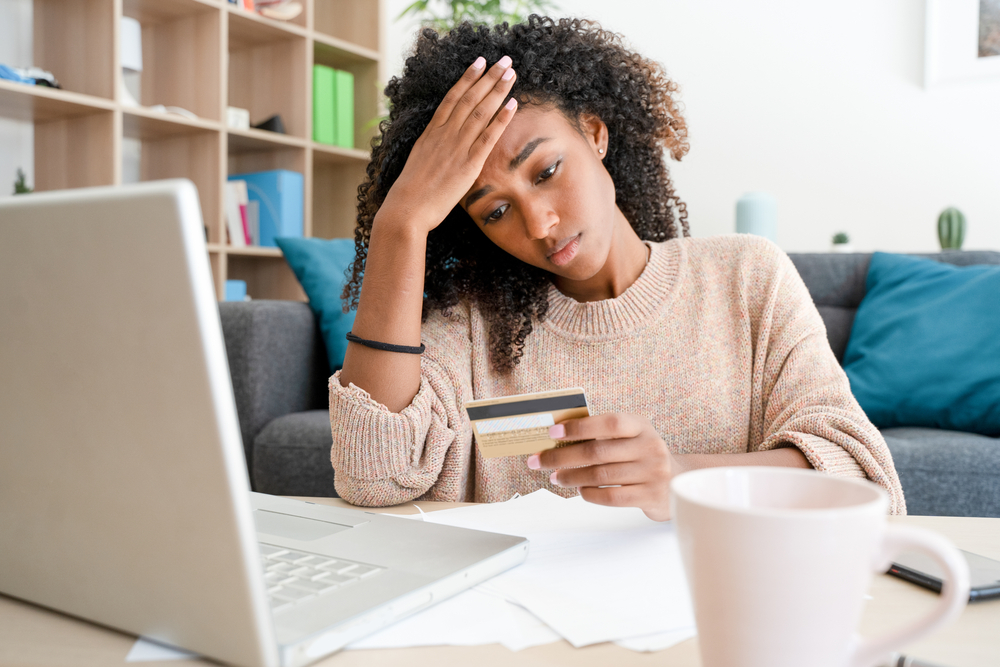Compare Personal Loans
Shop and Compare
How to Shed Your Credit Card Addiction
Americans owe a total of $934 billion in credit card debt – about $7,938 per household, according to data from Wallet Hub [1].
That figure is an average, with many U.S. cardholders owing much more in plastic-related debt. Low-income households, for example, possessed the highest credit card debt, at $10,308 [2].
Geography has something to do with the credit card debt issue. Alaska has the nation’s highest statewide credit card burden, with the average Alaskan owing $13,048 in card debt. California, Wyoming and Utah all have average credit debt of over $10,000, as well.
Additionally, the average credit annual percentage rate (APR) stands at 14.52%, adding to the big-spending cardholder’s credit card debt load [2].
RELATED: How to Get Out of Credit Card Debt
COVID Adding to Credit Card Debt Woes
The ongoing pandemic, loaded up with economy-ravaging lockdowns, has also triggered more usage of credit cards – especially by the low-income demographic who can least afford to pay the debt back.
“Many consumers, especially those who have lost their job, have resorted to using credit cards as a backup plan, and are continuing to build that debt up while they try to find new work, or build up their personal finances,” said
Alex Miller, founder of UpgradedPoints.com, an online travel site that provides analysis, data, reviews and in-depth guides to travelers. “Credit cards are an easy to access tool – most everyone has one, and it’s very easy to continue to swipe without realizing how much debt you’re actually accumulating.”
That all adds up to a ton of household cash being steered toward sky-high credit card bills – and big financial trouble ahead for individuals who tend to rely on credit cards for most – or even all – of their household spending.
“There are two reasons people are addicted to their plastic: instant gratification and access,” said Justin Baksh, chief clinical officer at Foundations Wellness Center, in Port St. Lucie, Fla. “Their spending mindset is ‘I want what I want and I want it now! That is a common phrase used in addiction treatment.”
Plus, when credit card addicts whip out their plastic, the feeling is that the debt really isn’t their own – at least not yet.
“Credit is borrowed with the intent to pay back,” said Baksh. “Ask yourself honestly: If you had to dip into your checking account or pay cash would you really make that purchase? In most cases, the answer would be no. Consequently, you get instant gratification and access to what you want, and it is not associated with any immediate pain.”
RELATED:
Breaking a Bad Habit
The good news? There are ways even seriously addicted credit card spenders can curb their overzealous spending and get back to square one – but it takes a big effort.
“Heavy credit card users can’t gradually eliminate card usage,” said Eli Bliluos, a professional hypnotist at the NYC Hypnosis Center in New York City who works with individuals with severe financial addictions. “Based on my experience with clients, cold turkey is the best way to go. It is similar to alcohol. Either you are on or off the wagon.”
Along with developing a budget and consolidating debt with a personal loan (which can total credit card interest debt by 50%) credit card addicts can take the following steps to break their bank account-draining plastic spending habits.
Get a handle on total card debt – all of it. Anyone currently living off their credit card can stop the madness by first calculating their total personal debt, credit cards included.
“After that, calculate how long it will take on their current minimum monthly payments to repay their card debt,” said Neil Roach, a remote work blogger at Boxroomoffice.com, who recently paid down $20,000 in credit card debt. “The understanding that what you spend today could take 6-to-12 months to repay in full, plus interest, can be a very effective way of deciding that credit cards simply aren’t for you.
“Make it the first thing you review each morning before you’ve even had a coffee because that’s how much you really owe,” he said. That not only gives you a good read on total card debt on a regular basis, it helps stop “impulse spending” – one of the biggest triggers of big credit card debt, Roach said.
RELATED: The Fastest Ways to Pay Off $50,000 in Debt
Don’t use downtime to indulge in more card spending. It’s no secret that long-term lockdowns – like the ongoing pandemic-related lockdowns – can easily lead to boredom.
“This restlessness can cause many card-swiping addicts to turn to online shopping as a way to pass the time,” said Jory McEachern, corporate relations manager for ScoreShuttle, in San Diego, Calif. “Not only is this a financial recipe for burdensome debt, it could also damage your credit by going over the recommended 30% utilization ratio.”
Close any accounts you don’t need. This move will prevent you from having access to unused credit. “Also, for accounts where you already have a balance, it will prevent you from counting to run up the credit line and will allow you to pay it off,” Miller said.
Cut up your cards. “Taking the shears to your credit card still allows you to keep your accounts up and active, but temporarily disables you from accessing your credit card line since you won’t have immediate access to the card and number,’ Miller added.
Focus your spending on debit cards. “Debit cards pull money directly from your checking account and don’t accumulate debt,” Miller added. “That way, if you can shift spending to debit cards, it will allow you to focus on paying down your credit cards.”
Otherwise, ignoring problematic credit card spending will leave you with few viable options if the debt train gathers momentum.
As Roach puts it, “if you keep going the way you are, you could wind up sitting down with a bankruptcy attorney before you reach another birthday.”
[1] https://wallethub.com/edu/cc/credit-card-debt-study/24400
[2] https://www.cardrates.com/advice/shocking-credit-card-debt-statistics/
What to know about personal loans, credit scores, and they can help you to pay off debt and more.How to Use Personal Loans


Brian O'Connell has been a finance writer at TheStreet, TheBalance, LendingTree, CBS, CNBC, WSJ, US News and others, where he shares his expertise in personal finance, credit and debt. A published author and former trader, his byline has appeared in dozens of top-tier national publications.




